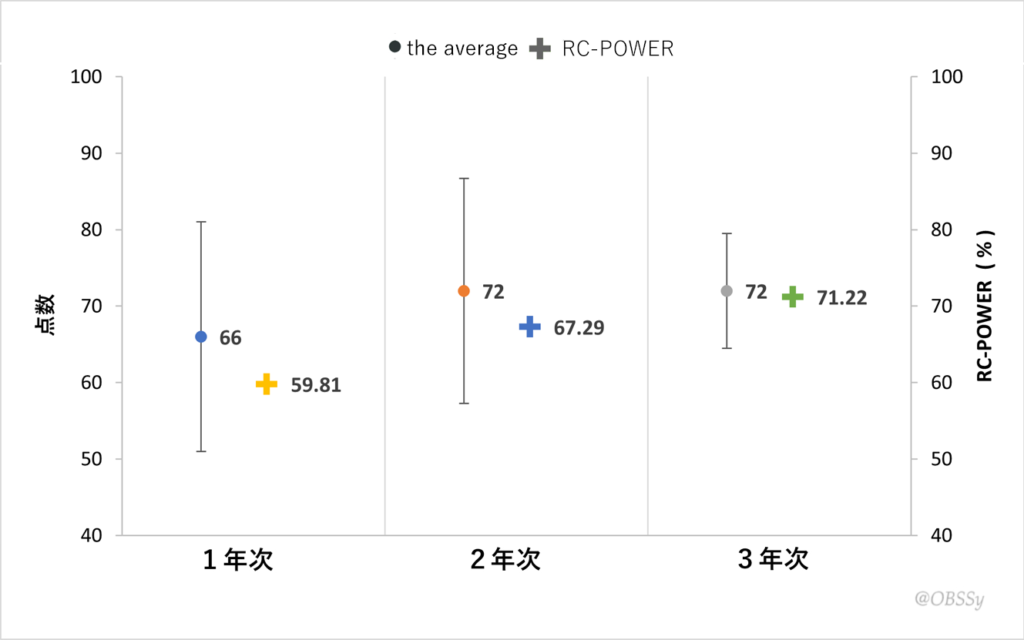RADAR CHART POWER ( RC-POWER )® shows whether the scores are high in a balanced manner using a single value into which mean and standard deviation(SD) are combined.
A healthy lifestyle consists of exercise, nutrition, and rest. The ideal balance of these three elements is essential for a healthy lifestyle. In this way, we try to capture the state by putting together those evaluations from multiple items.
In the same way, we try to estimate academic ability by putting together scores from multiple subjects. As an example, using scores, shown in Table 1, of mathematics(数学), Japanese(国語), science(理科), social studies(社会), and English(英語), let’s consider trends in academic achievement by the total score and the RC-POWER. For more information on RC-POWER, refer to RADAR CHART POWER.
Table 1 Scores for each subject (Out of 100 points).
| Aさん | 1年次 1st grade | 2年次 2nd grade | 3年次 3rd grade |
|---|---|---|---|
| 数学 | 80 | 60 | 70 |
| 国語 | 40 | 70 | 70 |
| 理科 | 70 | 60 | 80 |
| 社会 | 80 | 100 | 60 |
| 英語 | 60 | 70 | 80 |
Put together into one by the total score
The total score is a familiar way the count. Both mean and SD are necessary for the estimation of the variance of scores. Table 2 summarizes the total scores, mean, and SD in each grade.
Table 2 Total score, mean, and SD for each grade.
| Aさん | 1年次 1st grade | 2年次 2nd grade | 3年次 3rd grade |
|---|---|---|---|
| total score | 330 | 360 | 360 |
| mean | 66 | 72 | 72 |
| SD | 12.8 | 11.2 | 6.4 |
Figure 1 shows trends in the total score with a stacked bar chart. The chart shows the total score increases from the first grade to the second and keeps from the second to the third. Also, the chart shows the disparity between the subjects seems reduced, and as the grade advanced, the academic ability has improved to a balanced level.

Figure 1 Trends in the total score.
You can get a lot of information from the total score by adding mean and SD.
Put together into one by the RC-POWER
Figure 2 shows the radar charts to get the features of each grade at a glance. Then, from the area expansion of the radar chart, you can see that the total score has increased from the first grade to the second. Also, the radar charts become a well-shaped form from the second to the third. You can see that the academic ability has improved to a balanced level. In this way, we can see that academic ability has improved even if we observe the change in shape and size of the radar chart.

Figure 2 Trends in the score balance on radar charts
The RC-POWER of each grade is calculated as 59.81% for the first grade, 67.29% for the second, and 71.22% for the third. The unit is different between the point and the RC-POWER, but the range is the same. Therefore, Figure 3 shows RC-POWER and mean with SD in Table 2.
Figure 3 Trends in academic achievement by the RC-POWER and by the total score including mean and SD.
While the mean increases and SD decrease from the first grade to the second, the RC-POWER increases from 59.81% to 67.29%. As each SD is enormous, both RC-POWER is far below the mean. From the second to the third, the mean is the same, and SD decreases. The RC-POWER increases from 67.29% to 71.22%. In response to the decrease to the third, the RC-POWER is larger. You can see that the RC-POWER combines mean and SD into a single value.
Summary
- The total score requires both mean and SD to show whether the scores are high in a balanced manner, but the RC-POWER can show it by itself.
- The RC-POWER is suitable for a comprehensive evaluation because it is an index that combines mean and SD. It is a powerful guide to judgment.
Additional writing
You can use the RC-POWER to quantify the distortion of how well the radar chart is getting balanced scores, just as SD shows how widely the scores vary. Please get in touch with us for details. Contact us here.

